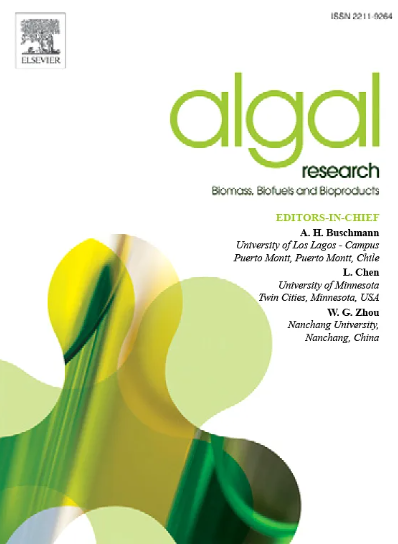Experimental and model-based parameterization of the fundamental process kinetics of Chromochloris zofingiensis
IF 4.6
2区 生物学
Q1 BIOTECHNOLOGY & APPLIED MICROBIOLOGY
Algal Research-Biomass Biofuels and Bioproducts
Pub Date : 2025-03-25
DOI:10.1016/j.algal.2025.104012
引用次数: 0
Abstract
The microalgae Chromochloris zofingiensis has attracted considerable interest due to its remarkable ability to accumulate high value metabolites. Current research focuses primarily on laboratory-scale cultivation, while the development of fundamental model frameworks for process upscaling is neglected. In order to develop an effective scale-up process for C. zofingiensis, it is crucial to identify the strain-specific kinetics and dependencies on the environmental factors affecting its growth (light, temperature, pH, nutrients and dissolved oxygen concentration), as many of them remain unknown. This study represents a combination of different experimental and model-based approaches to parametrize the key growth parameters of C. zofingiensis, as well as its response kinetics towards different cultivation factors for model framework construction and calibration. The optimal temperature, DOC and PAR intensity for photosynthesis were successfully determined to be 26.58 °C, 6–7 mgO₂/L, and 22.42 μmol/(m2 s), respectively. This enabled the development of a model-based control strategy, by maintaining the average PAR intensity within the PBR at its optimal range of 20–30 μmol/(m2 s), to ensure an efficient scale-up process, which effectively improved the productivity by a factor of 5 when scaling up the cultivation of C. zofingiensis to a 200 L pilot-scale PBR.
求助全文
约1分钟内获得全文
求助全文
来源期刊

Algal Research-Biomass Biofuels and Bioproducts
BIOTECHNOLOGY & APPLIED MICROBIOLOGY-
CiteScore
9.40
自引率
7.80%
发文量
332
期刊介绍:
Algal Research is an international phycology journal covering all areas of emerging technologies in algae biology, biomass production, cultivation, harvesting, extraction, bioproducts, biorefinery, engineering, and econometrics. Algae is defined to include cyanobacteria, microalgae, and protists and symbionts of interest in biotechnology. The journal publishes original research and reviews for the following scope: algal biology, including but not exclusive to: phylogeny, biodiversity, molecular traits, metabolic regulation, and genetic engineering, algal cultivation, e.g. phototrophic systems, heterotrophic systems, and mixotrophic systems, algal harvesting and extraction systems, biotechnology to convert algal biomass and components into biofuels and bioproducts, e.g., nutraceuticals, pharmaceuticals, animal feed, plastics, etc. algal products and their economic assessment
 求助内容:
求助内容: 应助结果提醒方式:
应助结果提醒方式:


